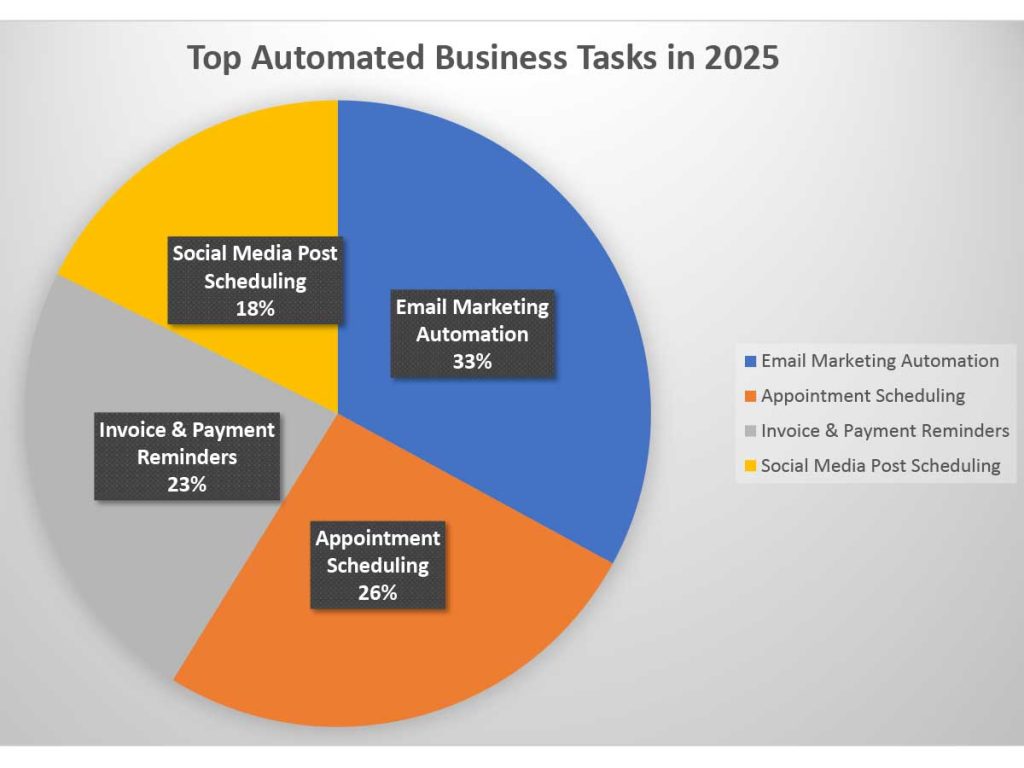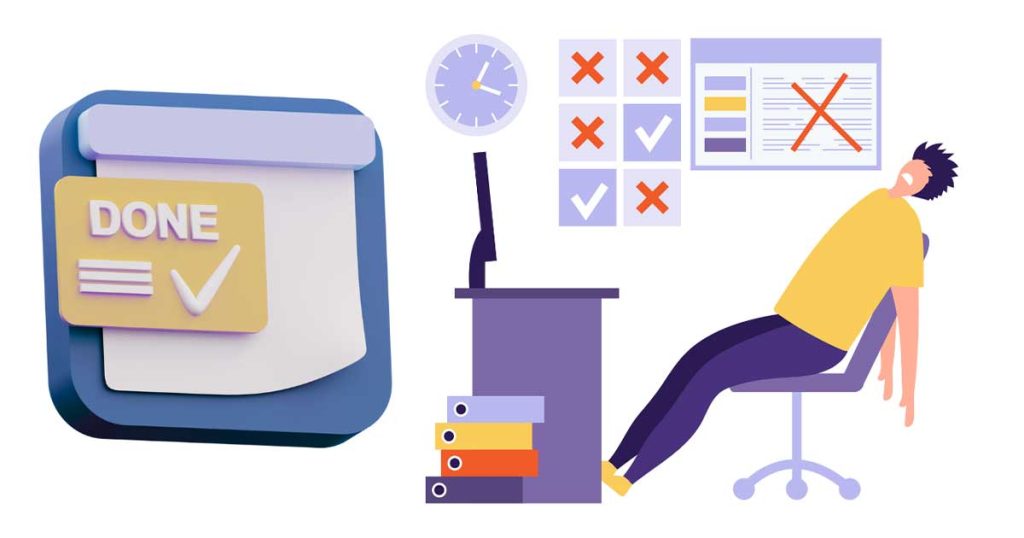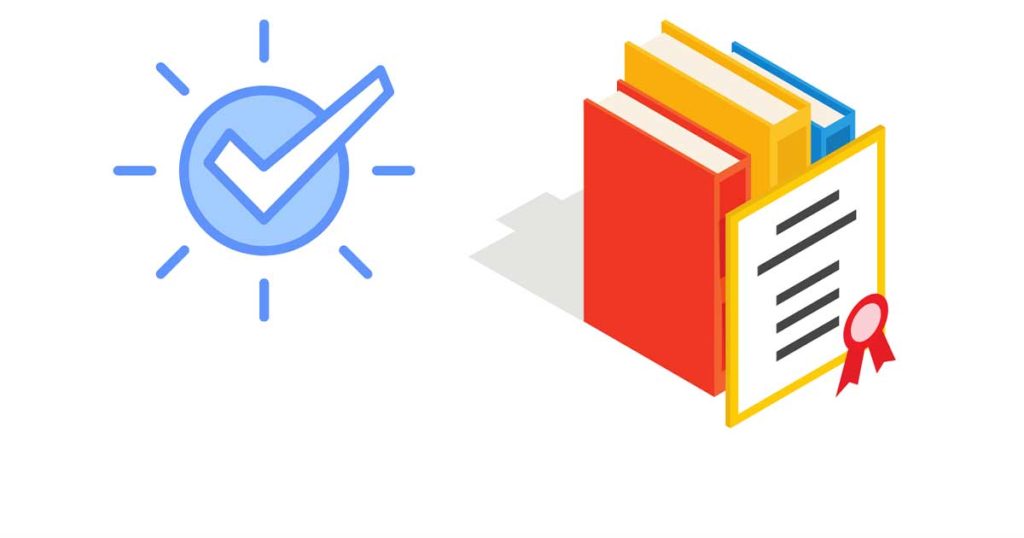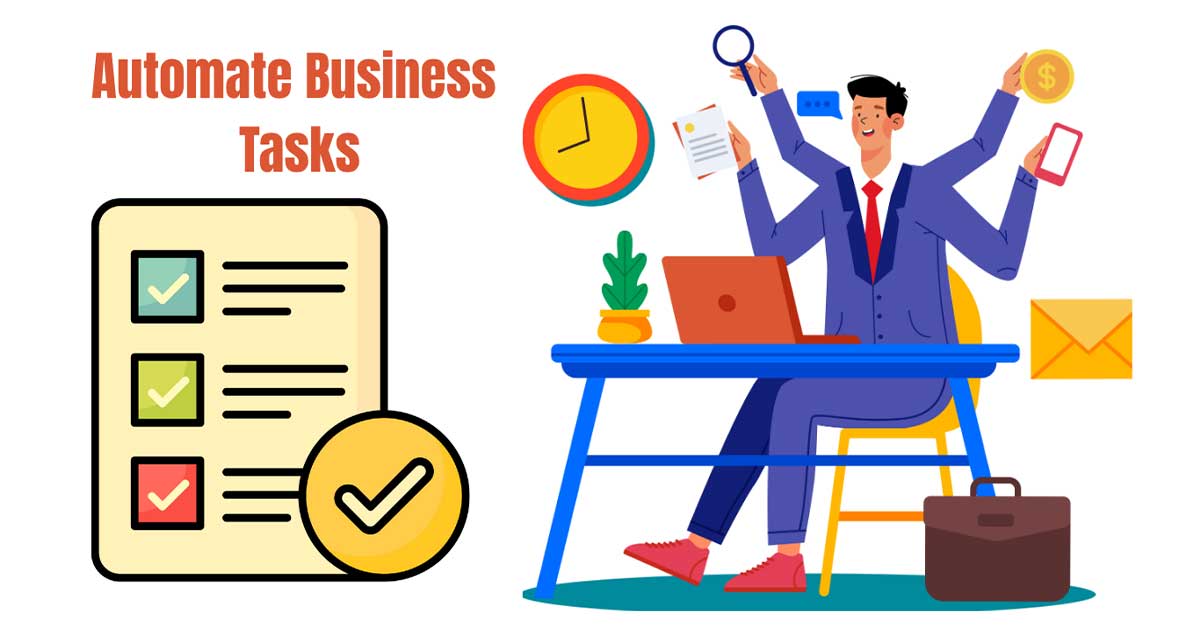Automate Business Tasks: Business owners have many small tasks. Writing emails, forms, and messages, as well as keeping track of sales, takes time away from achieving big goals.
Easy tools can automate business tasks. Automating helps workers finish more work with fewer mistakes. Focus on important things instead!
This blog outlines ways to automate for even better results in 2025 and beyond. It shows you the basics and valuable tools.
Key Takeaways:
- Use tools for lead creation, customer inquiries, expense reports, and staff schedules to save hours.
- Try these five easy automation applications.
- See how easily automating routine tasks saves four hours every day.
- Map your initial workflow with step-by-step screens and the right tool, no code.
- Reuse presentations on slow days and auto-update budgets to keep teams focused and costs low.
What Does Automate Business Tasks Mean?
Automation takes your repetitive tasks and hands them to friendly software, so you can spend more time growing the business and less time clicking “Copy and Paste.”
What Is Task Automation, Really?
Bad news: chores, sending invoices, moving data, checking stock, and leaning on people too much. Task automation swaps that drudgery for code and smart apps, letting work hum in the background while you steer the company forward.
Why Automate Business Tasks Need
These days, working fast is the name of the game, and that’s why automation has gone from being nice-to-have to must-have. Research shows that nearly half of the tasks people get paid to do could run on autopilot with the tech we have right now, and that switch saves both hours and dollars. When companies plug in automation, they usually see five big wins:
- Mistakes in everyday jobs drop way down.
- Stuff gets done faster and with less fuss.
- Workers gain hours for higher-level work.
- Every task looks and runs the same every time.
- Growth happens without a dollar-for-dollar jump in costs.
The Evolution of Business Automation
Business automation started out with simple checklists and set rules, but look where we are now: tools powered by AI that think on the fly. These smart systems can read data, weigh options, and even change course as new info pops up, all while getting a little bit sharper on their own over time.
Key Components of Successful Automation
For automation to fly instead of flopping, a few boxes need to be ticked:
Clear process documentation.
Scalable technology infrastructure.
Regular performance monitoring.
Employee training and adoption.
Integration capabilities with existing systems.
Common Time-Consuming Business Tasks
Whether answering emails, chasing invoices, or entering data over and over, many small, repetitive tasks steal time and energy from bigger goals. Let’s look at these drainers and how letting them run on autopilot can lift the whole team’s Focus and output.
Daily Administrative Tasks
Most of us spend a big chunk of the workday answering emails, booking meetings, and sorting through papers. Research finds that nearly 40 percent of an owner’s hours can vanish into these routine chores, and many of them are button’s away from being automated.
Data Entry and Documentation
Typing the same customer address for the tenth time or adjusting a single figure in inventory takes forever, and mistakes sneak in all the time. Whether you’re keeping client records, updating stock lists, or handling employee files, the work demands slow, careful attention.
Payment Processing and Invoicing
Pulling together receipts, crafting invoices, chasing unpaid bills, and matching Everything to the bank can swallow several hours each week. A hand-done system often falls behind, leading to late payments that starve cash flow and spoil supplier relationships.
Project Management and Task Tracking
Trying to steer a dozen projects by scribbling on sticky notes or endless spreadsheets quickly turns into chaos. Without a clear dashboard, checking who is on schedule, who is behind, and what still needs to start becomes a puzzle with missing pieces.
Communication and Follow-ups
Keeping the chat alive with clients, teammates, and partners through calls, texts, and scattered emails eats up time you could spend elsewhere. Each lead to chase, question to answer, or status update to share pulls focus again and again, breaking your train of thought.
Key takeaway: Business owners juggle many time-heavy jobs every day, but smart automation can trim those tasks, speed up work, and free up staff for higher-priority projects.
Automate Business Tasks 2025: How It Will Change Your Business
Are you still spending hours each week on the same old tasks, like sending emails, setting up meetings, or crunching figures in spreadsheets?
In today’s market, speed is everything, and you can’t afford to run and carry the same old weight. You can now hand off small tasks like sorting, remembering, and counting to a lot of apps and platforms, so you can run. Companies are already cutting thousands of hours off their work year. The message is clear: change or get left behind, whether you run a new business or a well-known brand in your area. You can achieve better results when you Automate Business Tasks
The phrase “automate business tasks 2025” is not only a passing fad. It’s the key to getting better results, less stress, and more time, time you can use to work on the next great thing. A simple way to boost efficiency is to Automate Business Tasks.
Manual Lead Generation and Customer Acquisition
Bringing in new leads and turning them into paying customers takes forever when done by hand. Sales teams often spend long hours hunting for prospects, personalizing each email, and entering every new name into endless spreadsheets.
Old-school methods mean scrolling through LinkedIn, showing up at mixers, and making cold calls one by one. That routine eats resources and covers far fewer people than tools that work while you sleep.
Agents end up with cluttered lists, piecing together where every lead is, and changing numbers on the fly. It’s no wonder they burn as much as 70 percent of their day on paperwork instead of actually talking to clients.A simple way to boost efficiency is to Automate Business Tasks.
Customer Support Management
As a business grows, keeping up with customer questions feels like masking a bursting dam. Routing emails and voicemails the usual way can slow replies and push even friendly customers to the door. You can achieve better results when you Automate Business Tasks
That’s why more companies are adopting chatbots and ticketing tools that run on autopilot. The software sorts, scores, and nudges staff so urgent problems get answered first and every customer feels seen on time.
Automated support workflows take the pressure off your help desk, letting chatbots and ticket rules handle simple questions. With routine checks off their plates, human agents can dive into tougher problems, and that quick hand-off usually leaves customers feeling more cared for.A simple way to boost efficiency is to Automate Business Tasks.
Financial Tracking and Reporting
Get your money matters in line by adding automation to tracking and reporting, starting with software like QuickBooks. It can sort expenses, balance accounts, and even label each entry, all while cutting your typing workload by up to 75 percent. Best of all, these tools spit out up-to-date reports and keep an eye on the numbers that really matter.
Modern systems can craft invoices, nudge clients for payment, and chase late bills on their own, freeing hours each week and speeding up cash flow. Cutting out human error in billing also means fewer credit disputes and steadier income throughout the month.A simple way to boost efficiency is to Automate Business Tasks.
Top-tier automation platforms can still go a step further by:
- Pulling in tailor-made financial reports that match your needs.
- Watching profit margins in real time so surprises stay small.
- Noting when spending slips past budget lines.
- Prepping tax-ready statements without a last-minute rush.
- Offering live dashboards that anyone on the team can read.
Employee Management
Keeping staff on the same page is another big piece of day-to-day operations. Modern time-tracking apps replace messy sign-in sheets with badges, mobile punches, and even facial clocks, letting managers see who is where at a glance. They also bundle vacation requests and sick leave notes into one clear calendar, so approvals take moments instead of days. You can achieve better results when you Automate Business Tasks
Automated time-and-attendance systems now scan faces or fingerprints, so clock-ins and clock-outs happen in seconds. The software then figures out total hours, overtime, and creates neat reports, wiping out the long grind of typing Everything by hand. A simple way to boost efficiency is to Automate Business Tasks.
A leave-request portal gives workers a simple way to ask for time off using their phones. Managers review the requests and approve or deny them with just one tap. The same tool keeps an up-to-date tally of each person’s remaining vacation days, sick hours, and patterns of absenteeism.
Immediate push-notifications mean everyone stays in the loop about who is in or out. Knowing a teammate’s status lets supervisors plan workloads more wisely and share tasks before deadlines sneak up.
Why You Should Automate Business Tasks in 2025 to Save Time and Stress
Do you ever feel like you’re spending more time on small tasks than actually growing your business?
That’s why more people are choosing to automate business tasks in 2025—and it’s changing the way they work.
In 2025, business owners are juggling emails, appointments, social media, and so much more. While these jobs are important, they eat up hours of the day that could be used to focus on big-picture goals. Thankfully, today’s technology allows you to automate business tasks with smart tools that handle the repetitive stuff for you.
With the help of automation tools, businesses can work faster, avoid mistakes, and stay organized without burning out their team. A simple way to boost efficiency is to Automate Business Tasks.
Automate Business Tasks 2025 is a smart and stress-free way to run a smoother, faster business by using tools that handle everyday work automatically.
| Type of Task | What Can Be Automated | Tools You Can Use | Benefits in 2025 |
|---|---|---|---|
| Emails & Follow-Ups | Welcome emails, reminders, thank you notes | Mailchimp, Convert Kit | Saves time and keeps customers engaged |
| Appointments & Scheduling | Booking meetings or services | Calendly, Google Calendar | No more back-and-forth texting |
| Social Media Posts | Posting content across platforms | Buffer, Later, Hootsuite | Keeps you active online without effort |
| Customer Support | Instant answers to common questions | Chatbots (Tidio, Intercom) | Helps customers even when you’re closed |
What does it actually mean to automate business tasks in 2025?
Have you ever wished you had more time in the day to finish all the work you need to accomplish for your business?
Automate Business Tasks in 2025 means employing smart software and technologies to do things that need to be done again and over again, such as sending emails, making appointments, helping customers, and making reports. Businesses can save time, make fewer mistakes, and focus on growth instead of busywork when they automate. You can achieve better results when you Automate Business Tasks
This pie chart depicts the most typical places where small and local firms will automate business tasks in 2025. It shows where automation is having the most impact and making it easier for business owners to get more done. A simple way to boost efficiency is to Automate Business Tasks.

Five Proven Automation Solutions
You don’t need to replace your entire tech stack to lighten the daily load. Try one of these five reliable tools and watch efficiency climb while routine drudgery shrinks.
AI-Powered Chatbots
Set up an AI chatbot to answer customer questions day and night. Built on natural language processing, it gives fast, accurate replies and sends real-time alerts when cases need a human touch. Since the bot can juggle dozens of chats at once, it shrinks response times by as much as 80 percent. Many companies now Automate Business Tasks to save time
CRM Integration Solutions
Pair Salesforce with LinkedIn Sales Navigator to smooth lead handling from first contact to close. Routine tasks such as updating addresses, assigning jobs, and firing off follow-up emails can run on autopilot. With that level of help, sales reps save hours, and the team boosts efficiency by roughly 40 percent, all while no hot lead slips through the cracks. Many companies now Automate Business Tasks to save time
Review Management Systems
Set up a review management tool like Social Pilot so you can watch and reply to customer feedback without extra pressure. By answering positive and negative reviews on time, these systems can boost customer happiness by roughly 65% and keep your brand looking its best. Many companies now Automate Business Tasks to save time
Smart Scheduling Systems
Use smart schedulers to cut the endless back-and-forth that comes with booking meetings. These friendly apps link to your calendar, send gentle reminders, and help drop no-show rates by about 40%. Because they plug into software you already use, they save time without extra hassle. Many companies now Automate Business Tasks to save time
Social Media and Email Automation
Bring in a service such as Hootsuite to run your ads and email sequences on autopilot. These tools line up posts, check how people interact, and handle several social accounts at once. When you pair them with email automation, open rates can rise by 30% thanks to timing and messages that feel personal.
Pick automation tools that match your business style and start small. Try one solution, watch the gains, and then add new features at a pace that feels right. Many companies now Automate Business Tasks to save time

AI-Powered Chatbots for Customer Support
Supercharge customer support with AI chatbots that field simple questions any hour of the day. Thanks to natural language tech, these virtual helpers grasp what customers really ask and reply quickly with accurate information. It makes sense to Automate Business Tasks in this situation
Key Features of AI Chatbots
- Natural Language Understanding: Responds based on context, not just keywords.
- Multi-Language Support: Chat in dozens of languages, meeting a global audience.
- Seamless CRM Integration: Links with existing systems, sharing data in real time.
- Real-Time Alerts: Flags urgent queries so agents can jump in fast.
- Auto Ticketing: Creates, sorts, and assigns support tickets without a human touch.
Benefits of Implementation
- Faster Replies: Cuts response time by up to 80 percent, keeping customers happy.
- Multi-Tasking: Juggles hundreds of chats at once, never missing a beat.
- Consistent Quality: Delivers the same level of service every minute, every day.
- Feedback Capture: Gathers insights that shape products and services.
- Agent Relief: Let’s human reps focus on tricky problems instead of basics.
Best Practices
- Start Small: Begin with the most common FAQs; expand over time.
- Keep it Fresh: Periodically refresh the knowledge base with new info.
- Track Metrics: Use dashboards to see what’s working and where to improve.
- Clear Escalation: Always give customers an easy way to reach a live agent.
- Be Conversational: Write responses as if a person were speaking, not a robot.
The best AI chatbots learn with every conversation, getting smarter and faster at solving problems. When tied to a CRM, they pull up purchase history and past tickets, letting customers feel understood from the first hello.

CRM Integration for Lead Management
Pairing chatbots with an advanced CRM can transform how you find, track, and nurture leads. Tools like HubSpot and Salesforce now include automation that moves deals through the pipeline, sends follow-ups, and even books demo calls, all on autopilot. With the busy work handled, sales teams spend more time building real relationships. It makes sense to Automate Business Tasks in this situation
Key Integration Features
- Capture leads automatically from web forms, social media, and email.
- Score each lead based on real engagement activities.
- Assign tasks to sales teammates without manual input.
- Track the entire pipeline and get analytics in real time.
LinkedIn Sales Navigator Integration
Link your CRM to LinkedIn Sales Navigator and watch qualified leads import on their own. This setup spots key decision-makers, tracks how they interact, and can boost your conversion rate by 17 percent. It makes sense to Automate Business Tasks in this situation
Automated Follow-Ups
Build a triggered email series that sends out when a lead does something important. If a prospect downloads a white paper or checks the pricing page, the system delivers the right follow-up content without delay. It makes sense to Automate Business Tasks in this situation
Pipeline Management
- Update lead status automatically.
- Notify teams when deals move stages.
- Remind reps of pending tasks.
- Show performance in easy-to-read dashboards.
After adding these CRM automations, companies say they save 2 to 3 hours each day on lead work and see better quality and higher conversion rates.
Key Features of Review Automation
- Real-time review tracking on Google, Yelp, and dozens of other sites.
- Automated follow-up requests are sent right after a purchase or service.
- Sentiment analysis that spots good and bad trends in seconds.
- Pre-written reply templates are ready for every kind of customer comment.
- Single dashboard where you see, manage, and reply to all reviews.
Implementation Benefits
- Saves 75% of the time usually spent hunting for new reviews.
- Boosts your reply rate by 60%, so no feedback gets left hanging.
- Keeps your voice the same everywhere with consistent, branded replies.
- Delivers quick insights about what customers really think.
- Flags service problems early, letting you fix them before they spread.
Services like Social Pilot Reviews and Bird eye plug right into tools you already use. They automate review requests via email or text, giving you a steady flow of genuine feedback. You can achieve better results when you Automate Business Tasks
The real win? You can turn on instant alerts for bad reviews, so you respond fast and protect your online image. Research shows that companies answering reviews within 24 hours enjoy 33% happier customers.

Scheduling and Calendar Automation
Finding a free spot for a meeting and keeping that spot clear takes more hours than most people like to admit. Luckily, scheduling apps now link right to your calendar, cutting out the endless email chain and letting everyone pick a time that works. Programs such as Calendly or Microsoft Bookings do this quietly in the background. It makes sense to Automate Business Tasks in this situation
Key Features of Calendar Automation
- Sync real-time availability from several calendars
- Convert meeting times smoothly for every time Zone
- Add buffer minutes between back-to-back slots
- Set custom rules over when and how people book
- Link directly to your favorite video call service
Smart Scheduling Capabilities
These systems spot new conflicts, gently remind everyone before the call, and even, based on rules you set, move the meeting if something else pops up. When a client claims an opening, the tool builds a video link in one click, sends a fresh calendar alert, and marks the time as busy on your end. It makes sense to Automate Business Tasks in this situation
Time-Saving Benefits
Research shows that companies free up around eight hours a month when they turn their calendars over to automation. The system takes care of everyday details, including:
- Sending meeting confirmations
- Delivering reminder alerts
- Handling cancellations and rescheduling
- Creating follow-up tasks after each meeting
Email and Social Media Automation
Managing emails and social media can eat up hours, but smart automation tools let you keep your brand visible with far less effort. Here’s a quick guide to streamlining both channels.
Automated Email Campaigns
Tools like Mailchimp and HubSpot turn email marketing into a hands-off process. You can build triggered email series, group customers by behavior, and plan newsletters weeks ahead. Built-in A/B tests show which subject lines and layouts drive opens and clicks. It makes sense to Automate Business Tasks in this situation
Social Media Scheduling
Services such as Hootsuite and Buffer let you line up posts for every major platform in one go. Plan a content calendar week early, press publish only once, and your feeds update on autopilot. Up-to-date analytics then show which posts spark conversations, so you can tweak future content. It makes sense to Automate Business Tasks in this situation
Cross-Platform Integration
Link your email and social media automation tools with your CRM so Everything talks to one another. When you do this, you can:
- Track every customer touchpoint, no matter where it happens
- Build ads that target people who opened emails but did not buy
- Pull fresh data automatically for personalized messages
- See live dashboards that show how every campaign is performing
Content Recycling
Use a tool like Meet Edgar to recycle older posts without your hands getting tired. With smart recycling, you can:
- Share successful content again and again on autopilot
- Keep social feeds busy even while you are sleeping
- Reach audiences in different time zones with the same post
- Free up hours that you would normally spend creating new stuff
Implementation Guide
Rolling out automation should feel like a planned dance, not a messy shuffle. Here is a simple roadmap to help you get the most bang for your buck. It makes sense to Automate Business Tasks in this situation
Pick One Process and Test
Launch a pilot in just one team or task, say customer support or weekly reporting. This narrow Focus lets you spot bugs and tweak settings before you hit the “company-wide on” switch.
Plan Before You Automate
Starting an automation project without a good plan is like building a house on sand. Before you dive in, take a moment to look around.
- Check Your Tech Stack: What hardware, software, and networks do you already own? Knowing this helps you spot gaps and overlaps.
- Set Clear Goals: Do you want to speed up invoices or cut data-entry errors in half? Write down specific targets so everyone pulls in the same direction.
- Draft a Timeline: Realistic timelines beat wishful thinking every time. Break the project into stages and estimate how long each will take.
- Budget for Training: New tools only shine when people know how to use them. Carve out time and funds for hands-on classes, documentation, and ongoing support.
Train Your Team Well
Rolling out a high-tech gadget is easy; getting your crew on board is harder. Focus training on four simple areas.
- Basic Features: Start with the big-picture menu. What can the tool do in plain English?
- How It Fits: Show how the new system hooks into the programs workers use every day.
- Fix-It Tips: Prepare a cheat sheet for common hiccups so problems don’t grind work to a halt.
- Smart Usage: Share shortcuts, keyboard tricks, and little-known tweaks that save time and clicks.
Monitor and Improve
Once the switch is flipped, the real journey begins. Keep an eye on things, listen to your team, and be ready to fine-tune.
- Spot-Check Health: Schedule light-audit sessions to see if the system runs as promised.
- Ask the Users: Surveys, chat boxes, and quick polls reveal frustrations you might miss.
- Let the Numbers Talk: Dashboards show speed gains, error drops, and any hidden drag on productivity.
- Count the Cash: Compare the costs of the old way versus the new to prove, or disprove, your ROI.
And don’t forget the chat. Via Slack, Teams, or plain email, keep the informal feedback loop open.
Lock Down Your Data
New technology opens business doors but can also invite unwelcome guests. Pair every cool feature with these security basics.
- Routine Audits: Bring in third-party experts at least once a year to poke around.
- Encrypt Everything: Shield sensitive records with strong encryption, both in transit and at rest.
- Limit Access: Use role-based permissions so only the right eyes see the right data.
- Back It Up: Keep daily, off-site backups ready to restore files in a hurry if something goes sideways.
Pick the Right Tools
Automation hype can blind even the savviest owner, so ground your choice in reality. Use this three-step filter.
- List Pain Points: Jot down the repeat tasks that chew up time, money, or staff morale.
- Seek All-in-Ones: A single platform with many features rarely costs less than a patchwork system and almost always causes fewer headaches.
- Trial Before You Trust: Most vendors still offer free pilots, so kick the tires and see how the platform behaves with your actual data.
Key Features to Look For
- Easy Integration: The tool should plug right into the apps you already use.
- Simple Dashboard: A clear, user-friendly dashboard lets everyone manage tasks without a steep learning curve.
- Strong Security: Look for features like end-to-end encryption and regular backups to keep your data safe.
- Room to Grow: Choose a platform that scales up as your team or customer base expands.
- Mobile Access: Being able to manage workflows from a phone or tablet adds a lot of convenience.
Cost Considerations
The listed price is only part of the story. Add in setup fees, staff training, and the gains you expect to see later. Industry experts often suggest starting with a free trial to see if the tool really delivers before committing. It makes sense to Automate Business Tasks in this situation
Evaluation Process
- Write down exactly what you need the tool to do.
- Search for software that meets those needs.
- Line up features side-by-side with their costs.
- See what actual users say in ratings and reviews.
- Try out any promising options during their free trial.
- Ask how fast and helpful their customer support really is.
Also, aim for systems that come with built-in segmentation so you can target audiences precisely and boost results.
Key takeaway: Pick automation software that fits your business, has all the key features, shows clear return on investment, and plays nicely with your current systems.
Setting Up Automated Workflows
Once you have the right tool, mapping out your day-to-day jobs is the first step. Circle repeat tasks like data entry, follow-up emails, or reporting, then program the software to handle them. You’ll save time, cut errors, and free your team to focus on bigger ideas. It makes sense to Automate Business Tasks in this situation
Define Trigger Points
Set clear starting signs that kick off actions in your daily workflow. For instance, every time a new lead fills out your contact form, the system can add that person to your CRM and send out a friendly welcome email.
Create Action Sequences
Map out a step-by-step chain of tasks that run on their own after a trigger. This chain might include:
- Assigning specific tasks to team members
- Generating contracts or reports
- Scheduling follow-up emails
- Entering data where it needs to go
Test and Optimize
Before rolling out any new automation, run a test on a small group.
- Watch for slow spots or errors
- Ask the team what worked and what didn’t
- Tune Everything based on feedback
Also, jot down each workflow so anyone can review it later. Checking the system regularly keeps the automations running smoothly and in line with your goals.
The bottom line: Smart workflow automation blends clear triggers, step-by-step actions, and ongoing testing to boost efficiency across the board.
Benefits for Business Owners
—Adopting automation tools can truly change the game for small and mid-sized business owners, streamlining daily tasks and freeing up time to focus on growth. Let’s look at the top advantages that make automation so appealing in today’s fast-paced market. You can achieve better results when you Automate Business Tasks
Gain Hours Back and Boost Focus
Business owners free up precious hours when they set repetitive tasks to run automatically. Instead of getting tangled in data entry or email sorting, they can steer their teams toward big ideas and future growth. This swing from day-to-day work to strategic planning opens doors for fresh projects and new markets. You can achieve better results when you Automate Business Tasks
Steady Accuracy and Zero Slip-Ups
Automation takes the human guesswork out of routine jobs, so quality stays the same every time. Whether printing invoices or sending out newsletters, a tamper-proof system hits its target again and again, trimming expensive errors and building trust with customers. You can achieve better results when you Automate Business Tasks
Trim Costs While Driving Returns
A smoother workflow usually shrinks overhead, from paper bills to staff overtime. Research shows automation can slice expenses by 20 to 30 percent-and do it fast. Most owners see their upgrade pay for itself in six to twelve months through lower wages and extra output. You can achieve better results when you Automate Business Tasks
Enjoy Life Beyond the Desk
For many founders, the best perk is simply time to breathe outside work. Once chatbots and scheduled reports pick up the slack, owners can leave the office or take a vacation, confident that the business will hum along.

Final Thoughts-Automate Business Tasks
Automate business tasks in your business. Stop wasting time on repetitive jobs.
Some people just spam clients with emails. They also update records monthly by hand. Bots could do these tasks instead. Automation can save people time and effort.
Robots cut down on repetitiveness. They also post to social media and process data quickly. This lets everyone focus on growing the company.
By 2025, if you want your business to thrive, think about robots doing tasks. You’ll be able to reduce stress, increase efficiency, and improve operations. You can achieve better results when you Automate Business Tasks

FAQs-Automate Business Tasks
What does it mean to automate business tasks ?
Automating business tasks means using tools like software for similar functions of sending emails, arranging meetings, or tracking sales. Automation can save a lot of time, allowing one to concentrate more on principal areas that require attention.
What are the benefits of automating business tasks?
Automation improves speed and reduces errors. Fewer repeated tasks make room for growth. Time saving gives space for focusing on essential things.
What are some simple ways for beginners to automate business tasks?
Start automating with Google Calendar or Zapier to send newsletters or reminders. Small efforts yield big impacts on productivity and stress.
Is it possible for small enterprises to afford to automate their work?
Certainly! There are many affordable options available for small businesses. Although automation may require an initial investment, error reduction and freed-up time can increase profit potential later.
How can I tell which solutions are suitable for automating business processes in my company?
Identify time-consuming tasks such as scheduling, billing, or repetitive emailing. Then search for apps that automate these tasks. Reviews online help narrow down what works best according to individual needs and budgets.

